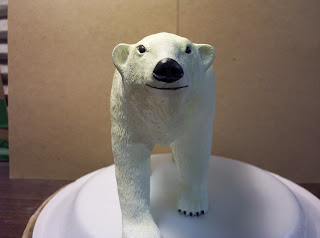The polar bear texture is finished. Today I will post several articles covering all the steps in the painting process. I had said in an earlier post that the texturing adds a look of realism to the bear. If that is true then to me the painting brings him to life. In the following pictures I have sealed the bear with the seal coat and applied the first coat of gesso.
A couple of points here, the seal coat is used because I use water based paints. If I don't seal the carving some of the finer texture may fill in due to the water in the paint causing the wood to swell.
Gesso is a heavy bodied primer used by artist to prime their canvas prior to painting. It is much too heavy for finely textured wood carvings. It does however provide a good base for painting. Although it says not to, I thin the gesso to about the consitency of whole milk, and with a stiff bristled brush I will scrub the gesso into the texture. Like the entire painting process I may have to do this several times to cover all the marks left by the woodburner. If I were carving a black bear or grizzly I would not have to worry too much about some of the marks showing as they would blend in with the final coats of paint. With a polar bear I can only get by with a few showing. A polar bear has black skin, but I don't want too many showing through, because then the bear would look like he has the mange. Can't have that, I want him looking fat and healthy.
Here I have applied three coats of the sealer. Again I use a 50/50 mix of Deft and laquer thinner.
Here I have scrubbed in the first coat of thinned gesso. In the second picture on the face you can see heavy black marks that I put on to show the flow of the texture. I did this thinking it would be easier for you to see on the blog. I found out pencils marks show up just fine and now will have to deal with it throughout the painting. As I said on a dark colored bear not a problem, on a polar bear not so good. Remind me not to do that again.





















































